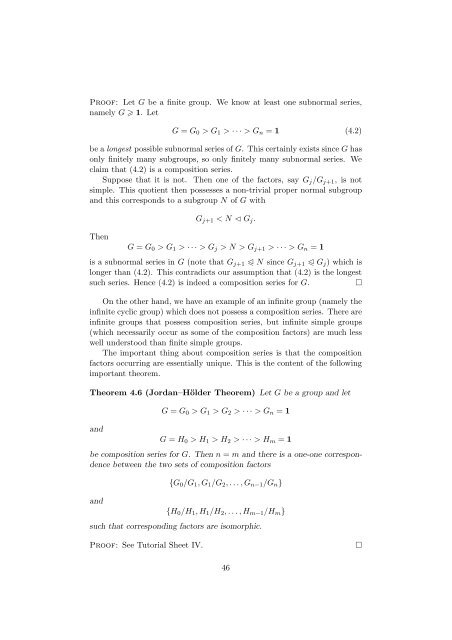The JordanâHölder Theorem
The JordanâHölder Theorem
The JordanâHölder Theorem
You also want an ePaper? Increase the reach of your titles
YUMPU automatically turns print PDFs into web optimized ePapers that Google loves.
Proof: Let G be a finite group. We know at least one subnormal series,<br />
namely G 1. Let<br />
G = G 0 >G 1 > ···>G n = 1 (4.2)<br />
be a longest possible subnormal series of G. ThiscertainlyexistssinceG has<br />
only finitely many subgroups, so only finitely many subnormal series. We<br />
claim that (4.2) is a composition series.<br />
Suppose that it is not. <strong>The</strong>n one of the factors, say G j /G j+1 ,isnot<br />
simple. This quotient then possesses a non-trivial proper normal subgroup<br />
and this corresponds to a subgroup N of G with<br />
<strong>The</strong>n<br />
G j+1 G 1 > ···>G j >N>G j+1 > ···>G n = 1<br />
is a subnormal series in G (note that G j+1 N since G j+1 G j )whichis<br />
longer than (4.2). This contradicts our assumption that (4.2) is the longest<br />
such series. Hence (4.2) is indeed a composition series for G.<br />
□<br />
On the other hand, we have an example of an infinite group (namely the<br />
infinite cyclic group) which does not possess a composition series. <strong>The</strong>re are<br />
infinite groups that possess composition series, but infinite simplegroups<br />
(which necessarily occur as some of the composition factors) aremuchless<br />
well understood than finite simple groups.<br />
<strong>The</strong> important thing about composition series is that the composition<br />
factors occurring are essentially unique. This is the content of the following<br />
important theorem.<br />
<strong>The</strong>orem 4.6 (Jordan–Hölder <strong>The</strong>orem) Let G be a group and let<br />
and<br />
G = G 0 >G 1 >G 2 > ··· >G n = 1<br />
G = H 0 >H 1 >H 2 > ···>H m = 1<br />
be composition series for G. <strong>The</strong>nn = m and there is a one-one correspondence<br />
between the two sets of composition factors<br />
and<br />
{G 0 /G 1 ,G 1 /G 2 ,...,G n−1 /G n }<br />
{H 0 /H 1 ,H 1 /H 2 ,...,H m−1 /H m }<br />
such that corresponding factors are isomorphic.<br />
Proof: See Tutorial Sheet IV.<br />
□<br />
46













